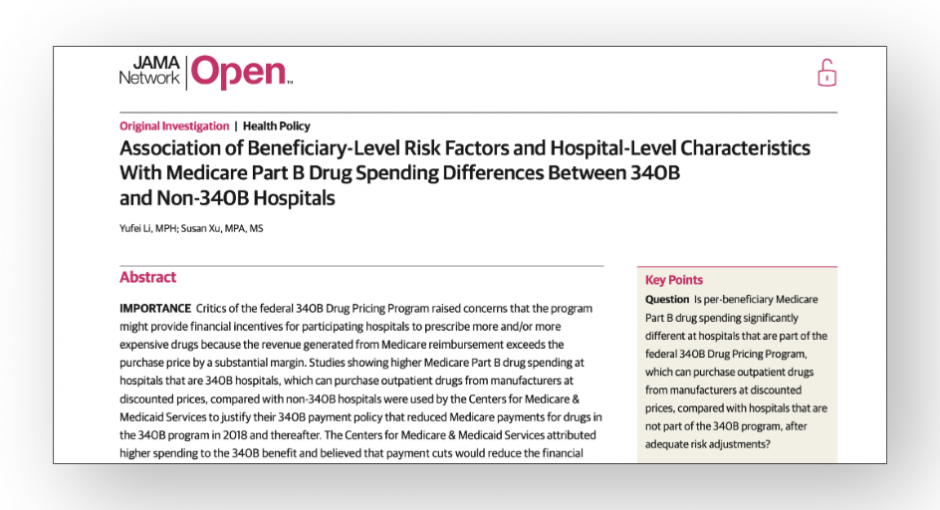New research published in JAMA Network Open “raises doubt” about a major U.S. Centers for Medicare & Medicaid Services (CMS) justification for slashing hospitals’ Medicare Part B reimbursement for drugs purchased through the 340B program by almost one-third, the study’s authors say.
Yufei Li, a data analyst at VA Boston Healthcare System, and Susan Xu, senior director at McDermott+Consulting, said they found “no statistically significant difference in Medicare Part B drug spending between 340B hospitals and non-340B hospital” after controlling for differences in patient population and hospital characteristics. Their report was published online on Feb. 18.
Xu was the former director of payment policy research and analytics at the Association of American Medical Colleges (AAMC) until May 2021. Li was a health care affairs research fellow at AAMC from October 2020 until December 2021, during which time she worked on the study.
AAMC is one of the three hospital groups whose lawsuit against CMS challenging the legality of the nearly 30% cut in 340B hospitals’ Part B drug payments will be decided soon by the U.S. Supreme Court. The court heard arguments in the case in late November.
Also in November, CMS announced that it would continue the payment reduction in place since 2018 for another year. CMS has estimated that its policy reduces 340B hospitals’ Part B drug payments by about $1.6 billion a year.
When CMS announced the first payment cut in December 2017, it cited studies issued in 2015 by the Government Accountability Office (GAO) and the Medicare Payment Advisory Commission (MEDPAC) that it said “highlight a difference in Medicare Part B drug spending between 340B hospitals and non-340B hospitals.” CMS also has justified the cuts on other grounds.
GAO found that in 2008 and 2012, per beneficiary Part B drug spending was substantially higher at 340B DSH hospitals than at non-340B hospitals and that the differences did not appear to be explained by the hospital characteristics or patients’ health status. MedPAC reported that, from 2008 to 2012, Part B drug spending for chemotherapy drugs and drug administration increased faster among 340B DSH hospitals than among non-340B hospitals.
MedPAC subsequently reported in March 2020 that it found “no clear evidence of increased spending on cancer drugs” among hospitals that enrolled in 340B between 2013 and 2017. In market locations where a higher-than-average proportion of patients get cancer care in 340B hospitals, it found no higher drug spending at 340B hospitals for breast cancer, colorectal cancer, and leukemia/lymphoma. It did find higher spending for lung cancer and prostate cancer but said “the overall effect on beneficiary cost sharing is likely to be modest and vary by beneficiaries’ supplemental coverage.”
Hospital group 340B Health issued a study in 2018 that found that found that 340B DSH hospitals provide a higher level of care to low-income patients compared to non-340B hospitals and are more likely than non-340B hospitals to provide specialized services that are critical to vulnerable patients but are often underpaid.
Li and Xu examined 2017 claims data from a random sample of Medicare fee for service beneficiaries. The sample included 35,364 beneficiaries and 2,446 hospitals.
The study found there was a higher percentage of teaching hospitals among 340B hospitals than non-340B hospitals (56.3% versus 27.6%) and beneficiaries who went to 340B hospitals were more likely to be non-white than those who went to non-340B hospitals (17.6% versus 11.5%).
“The Part B drug spending difference between 340B and non-340B hospitals was not statistically significant after controlling for beneficiary-level risk factors and hospital-level characteristics,” Li and Xu said.
“The results show that the differences in patient population and hospital-level characteristics may explain drug spending differences between 340B and non-340B hospitals, which raises doubt about the financial incentive theory of the 340B program drug discount and the justification for the Centers for Medicare & Medicaid Services’ 340B payment policy,” they concluded.


